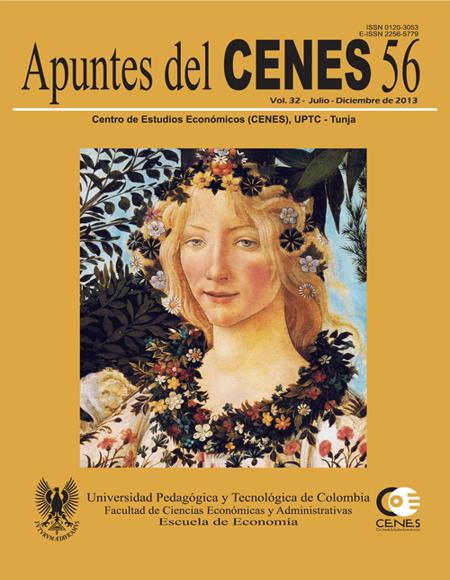Theory of the Pecking Order versus theory of the Trade Off for the company Coservicios S.A. E.S.P

Abstract
This paper aims to analyze the degree of application of two theories of capital structure that have been contradictory and extensively compared. For the implementation of the Trade Off theory are used two models, the first proposed by Lopez and de Luna (2002) and the second model to be applied is that proposed by Cruz et al. (2003). For the implementation of the Pecking Order theory is analyzed how stocks have been managed, longterm debt, the growth of net operating assets, the trend that has been operating profitability of assets and EBITDA. At the end you will find that in the periods analyzed the most used theory has been to Pecking Order which has been more empirical evidence in other organizations and that Trade Off theory application was not found.
Keywords
capital structure, trade off, pecking order, debt level, cost of capital.
References
- Acuña, G. (2010). El costo de capital de empresas no cotizantes en bolsa. Una aproximación teórica. Ponencia presentada en el II Congreso Internacional de Administración, Investigación –Evolución– Estrategia, realizado en la Universidad Pedagógica y Tecnológica de Colombia, de Tunja, Boyacá.
- Averch, H. & Leland , J. (1962). Behavior of the firm under regulatory constraint. The American Economic Review, 52 (85), 1052-1069. Recuperado de: http:// www.jstor.org/stable/1812181
- Banco de la República (2010). Informe de la Junta Directiva al Congreso de la república. Recuperado de: http:// www.banr ep.gov.co/documentos/ publicaciones/informe_congreso/2010/ marzo.pdf
- Banco de la República (2011). Series estadísticas. Recuperado de: http:// www.banrep.gov.co/series-estadisticas/ see_tas_inter.htm
- Besanko,D.& Spulbert,D. (1992).Sequential equilibrium investment by regulated firms.Rand journal of economics, 23 (2), 153-170. Retrieved from: http:// www.jstor.org/stable/2555981
- Bradley, M., Jarrell, G. & Han Kim, E. (1984). On the Existence of an Optimal Capital Structure: Theoryand Evidence. Journal of Finance, 39 (3), 857 878. Retrieved from: http://www.jstor.org/stable/ 2327950
- Compañía de Servicios Públicos de Sogamoso COSERVICIOS S.A E.S.P (2009). Informe de gestión años 2007 y 2008. Estados financieros.
- Cruz, J., Villareal, J. & Rosillo, J. (2003). Finanzas corporativas. Valoración, política de financiamiento y riesgo. Bogotá: Thomson.
- Damodaran Online.(2010, noviembre). Levered and unlevered betas by industry. Retrieved from: http://pages.stern.nyu.edu/~adamodar/
- De Angelo, H. & Masulis, R. (1980). Optimal capital structure under corporate and personal taxation, Journal of Financial Economics. (8), 3-29.Retrieved fromhttp://papers.ssrn.com/sol3/papers . cfm abstract_id=1482270
- Dirección de Impuestos y Aduanas Nacionales -DIAN-. (2007). Ley 1111 de 27 de diciembre de 2006. Recuperado de: http://www.dian.gov.co/dian/ 13Normatividad.nsf/1cffb08b38cf8c 9f05256f88006639f0/6be18f16c6a99b93 052572530056818a?OpenDocument
- Empresa de Servicios Públicos de Sogamoso COSERVICIOS S.A E.S.P. Estados financieros de COSERVICIOS S.A E.S.P. para los años 2007, 2008, 2009, 2010 y 2011.
- Empresa de Servicios Públicos de Sogamoso COSERVICIOS S.A E.S.P. (2009). Informe deGestión de COSERVICIOS S.A E.S.P. para los años 2007 y 2008.
- Frank, M.&Goyal, V. (2007). Trade-off and Pecking Order Theories of Debt. Hand book of Corporate Finance: Empirical Corporate Finance, 2. Retrieved from http://mba.tuck.dartmouth.edu/pages/ faculty/Espen.Eckbo/PDFs/ Handbookpdf/CH12-PeckingOrder.pdf
- García, O. (2003). Valoración de empresas, gerencia del valor y EVA. (1ra ed.). Cali: Prensa Moderna Impresores.
- Jaramillo, M. (2009). Análisis comparativo de la estructura de capital de tres grandes empresas pertenecientes al subsector de construcción de obras de ingeniería civil, en el período 1998- 2005. Santa Fe de Bogotá. Tesis para optar por el título de magíster en Administración. Universidad Nacional deColombia.
- Jensen, M. & Meckling, W. (1976). Theory of the Firm: Managerial Behavior, Agency Costs, and Capital Structure. Journal of Financial Economics, (3), 305 360. Recuperado de: http://hupress.harvard. edu/catalog/JENTHF.html
- Kim, E. (1978). A mean-variance theory of optimal capital structure and corporate debt capacity. Journal of Finance, 32(1), 45-63.
- Lopez, F. & De Luna, W. (2002). Finanzas corporativas en la práctica. Madrid: McGrawHill.
- Miller, M. (1977). Debt and taxes. Journal of Finance, 32, 261-275. Retrieved from: http://www.jstor.org/stable/2326758
- Modigliani, F. y Miller,M. (1963). “Corporate income taxes and the cost of capital: A correction”. American Economic Review, 53 (3)Recuperado 12/10/2011 de: http://www.jstor.org/stable/2326758
- Moreno, M. (1985). Costes de dificultades financieras y política de endeudamiento empresarial. Revista de Economía y Empresa, 5 (12 13), 252-273. Recuperado 05/05/2012 de: http://dialnet. unirioja.es/servlet/articulo?codigo=2528720
- Myers, S. (1984). PresidentialAddress: TheCapital Structure Puzzle.Journal ofFinance, 39(3).575 592. Retrieved from: http://www.jstor.org/stable/2327916.
- Myers, S. & Majluf, N. (1984). Corporate Financing and Investment
- Decisions When Firms Have Information that Investors do not Have. Journal of Financial Economics, 13,187 221. Retrieved from http://dspace.mit.edu/bitstream/handle/1721.1/2068/SWP 152315376412.pdf;jsessionid=1C74E8DF960E46E73FAFA4DAB863 n 941
- Robichek,A. (1978). Regulation andmodernfinance theory. The Journal of Finance, 33 (3), 693-705. Retrieved from: http:// www.jstor.org/stable/2326465
- Sarmiento, R. (2006). Una aproximación metodológica para determinar la estructura de capital de una firma regulada. Cuadernos Latinoamericanos de Administración, II (1), 33-51. Retrieved from: http://www.uelbosque.edu.co/files/Archivos/file/unaaproxmetodo logica.pdf
- Shapiro, A. (1991). Establishing a capital structure. In Modern corporate finance. (pp. 458-486). New York: Maxwell MacMillan International.
- Shyam, L. &Myers, S. (1994). Testing Static Trade-off against Pecking OrderModels of Capital Structure. MIT Sloan School of Management Cambridge. Working Paper No. 3677. Retrieved from http://dspace.mit.edu/bitstream/handle/1721.1/49224/testingstatict a00shya.pdf?sequence=1
- Spiegel, Y. & Spulber, D. (1994). The capital structure of a regulated firm. Rand Journal Economics, 25 (3). Retrieved from: http://www.tau.ac.il/~spiegel/papers/cap-structure-RJE-1994.pdf
- Superintendencia de Servicios Públicos Domiciliarios. (2010). Estudio sectorial acueducto y alcantarillado 2006-2009. Recuperado de: http://www.superservicios.gov.co/c/document_library/get_file uuid=89c00aaa-8fe2-479d-b1adba85f5577e52&groupId=342818
- Tenjo, F., López, E. & Zamudio, N. (2006). Determinantes de la estructura de capital de las empresas colombianas (1996- 2002). Borradores de Economía. Recuperado de: http://www.banrep. gov.co/docum/ftp/borra380.pdf
- Warner, J. (1977). Bankruptcycosts: some evidence. The Journal of Finance, 32 (2), 337-347. Retrieved from http:// www.jstor.org/pss/2326766
- Weston, J. & Copeland, T. (1995). Finanzas en administración, tomo II. (Novena ed.). MexicoD.F.:McGrawHill Interamericana.
- Zambrano, S. & Acuña,G. (2011). Estructura de capital. Evolución teórica. Revista Criterio Libre, 9 (15), 81-102. Recuperado de: http://www.unilibre.edu.co/CriterioLibre/images/revistas/15/ art3.pdf